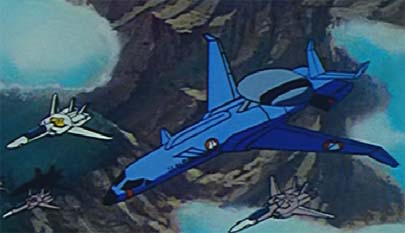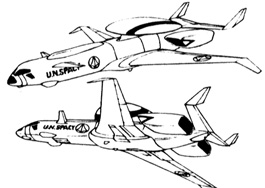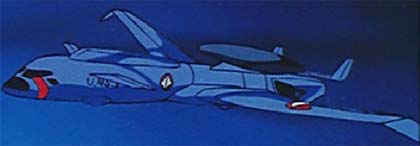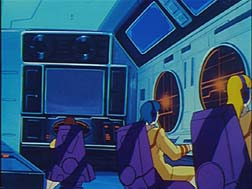EC-33 "Tracer" Airborne Warning and Control Vehicle
(Version 1.0 - Last updated:
05/31/02)
- Background and RPG stats by Kenneth
Olson
- Based on a design shown in Robotech Episode 32 "Broken Heart"
BACKGROUND
 The EC-33 "Tracer" was designed for the United States Air force
as the primary airborne early warning and control system (AWACS) during the
Global Civil War of the late 1990's as a replacement for the aging E-3 Sentry
system. The EC-33 was designed to carry an extensive mission avionics
package to provide long-range target acquisition of identification of both air
and land based targets, and control/communications for directing other combat
aircraft to targets. Although several proposals were considered including
the use of Boeing 767 aircraft, a modified MD-90-50 airframe was chosen because
lower unit costs, maintenance and greater reliability.
The EC-33 "Tracer" was designed for the United States Air force
as the primary airborne early warning and control system (AWACS) during the
Global Civil War of the late 1990's as a replacement for the aging E-3 Sentry
system. The EC-33 was designed to carry an extensive mission avionics
package to provide long-range target acquisition of identification of both air
and land based targets, and control/communications for directing other combat
aircraft to targets. Although several proposals were considered including
the use of Boeing 767 aircraft, a modified MD-90-50 airframe was chosen because
lower unit costs, maintenance and greater reliability.
The EC-33 is similar to previous generations of AWACS aircraft;
however, the use of the smaller MD-90 airframe reduces the aircrafts
venerability while in the air, allows the vehicle to fit into much smaller and
less costly hardened bunkers while on the ground, and reduced the overall
maintenance cost. The basic airframe of the MD-90 has been lengthen by
nearly 2 meters and strengthened to allow the inclusion of a the AN/APY-3 system
on a top mounted ray dome. A new tail, forward canard, and wing assembly
were designed to improve the aerodynamic efficiency of the unit and to allow for
increased fuel loads necessary for long duration missions. Four
Rolls Royce BR715-C1-30 turbofan engines, each providing over 93 kN of thrust,
are mounted in the rear not only to provide the additional thrust needed to
propel the vehicle but to power the nearly two MW electric needed for the radar
systems.
The EC-33 mounts a AN/APY-3 multi-mode S-band pulsed Doppler
system on a top mounted ray dome which rotates at 6 rpm. The AN/APY-3 is a
liquid-cooled phased array radar with an estimated effective radiative power 105
dBW. The system has the capability of scanning in both elevation as well
as azimuth and thus can revisit targets if necessary until the ray dome rotates
up to 60 degrees away from the target. The system can operate in both low-PRF
pulsed modes to enable the detection long-range targets beyond the horizon or
high-PRF modes to detect all-altitude targets out to the radar line of sight.
The system is capable of detecting 0 dBsm targets, in high PRF mode, out to
nearly 600 km. In addition, the AN/APY-3 has the capability to operate as
a radar jammer providing broadband protection using the full radiative power of
the system.
In addition to its airborne detection capabilities, the EC-33
mounts a powerful AM/AP-110 radar on two electronically-scanned conformal
antenna on top of the main body in front of the surveillance radar. The AP-110 has 30 separate modes
including the capability to operate as both a Moving Target Indicator (MTI) or
as a Synthetic Aperture Radar (SAR) which allows the system to paint a picture
of ground based targets and to aid in targeting. Target quality
coordinates are thus provided to the EC-33's associated fighters which can
either attack them directly or use long ranged stand off weaponry.
By combining a powerful surveillance radar with a multi-mode
SAR, the EC-33 thus replaced both the E-3 Sentry and E-8 Joint Stars in the USAF.
The system was so successful, that by the end of the Global Civil War nearly 125
EC-33 block-10's were build and fielded in large numbers by all members of the
Western Alliance. Although production of the original Block-10 model ended
in 2001, the EC-33 continued to soldier as the main Airborne Warning and Control
vehicle during the early years of the Robotech Defense Force.
Early in the formation of the RDF, military planers concentrated
on building purely combat units such as variable fighters and Destroids;
however, by late 2008 designers decided to reengineer the EC-33 aircraft using
the advanced materials and electronics salvaged from the SDF-1.
Using an advanced titanium composite theEC-33 block-20 model was thus provided
with nearly double the armor protection of the earlier block-10 models at no
increase in weight. The older AM/AP-110 radar was kept; however, a new
AN/APY-4 surveillance radar was mounted thus providing nearly 10 dB additional
performance over the earlier -3 model. Although, protoculture powered
engines were originally considered, designers decided that the expense and still
experimental nature would be overkill for a this vehicle. As a result, the
EC-33 block-20 model mounts four conventionally powered Rolls Royce BR715-C1-50
turbofan engines each providing 124.5 kN of thrust.
Production of the block-20 started in 2009 with the first
operational squadron forming later that same year. The Robotech Defense
Force had originally decided to retrofit older block-10 models to the newer
block-20 standard; however, the costs of retrofitting the older units proved too
expensive and all of the older block-10 models were placed into mothballs by
2010. A total of 107 block-20 models were produced from 2009 until the
Zentraedi bombardment of the Earth in 2011 during which 76 units were destroyed.
The remaining 31 units were fielded by the RDF in six squadrons of five with one
training aircraft in reserve. Three of the squadrons were placed in South
America to provide the RDF with 24 hour surveillance around the Zentraedi
control zone. The EC-33 proved highly successful in directing both
veritech fighters against airborne targets and Destroid units using its foliage
penetrating SAR radar against terrestrial based units. Not a single EC-33
was lost in combat; however a oneunit was lost in 2015 due to engine malfunction
and three units were destroyed on the ground due to a successful Zentraedi
sabotage mission.
With the departure of the SDF-3 in 2022 the remaining
twenty-seven EC-33 were placed under the operational control the the Southern
Cross Tactical Air Forces. The units were moved back from their forward
deployed bases in the old Z-zone to protect the Monument City, the Far East and
European Quadrants. The ASC used the EC-33 block-20s throughout the Second
Robotech War to a much more limited success than the earlier RDF operations as
the Robotech Masters generally attacked from orbit and thus reduced the amount
of warning time the EC-33 could provide. A total of 10 units were
destroyed during the Second Robotech War and all of the remaining units are
believed to have been destroyed with the Invid Invasion 2031.
RPG STATS
- Vehicle Type: EC-33
- Class: Airborne Warning and Control Vehicle
-
Manufacturer: Boeing Aerospace under contract to the Robotech Defense
Forces
Crew: Typically 17 (four flight crew and 13 mission crew) however
additional crew may be added as necessary. Breakdown is as follows:
- Two pilots
- 1 navigator
- 1 flight engineer
- 1 tactical director
- 3 fighter directors
- 5 surveillance operators
- 2 communication operators
- 1 radar technician
- 1 computer display technician
- Service History:
-
E-12/Block 10: Served with the United States Air Force from 1995 until
2002 and later with the RDF Air Force from 2001 until 2012.
- E-12/Block 20: Served with the RDF Air Force from 2009 until
2020 and later with the Armies of the Southern Cross Tactical Air Force from 2018 until 2031
-
MDC BY LOCATION:
| Location |
E-33 / Block 10 |
E-33 / Block 20 |
| * Pilot's Cockpit |
30 |
100 |
| Forward Canards (2) |
10 each |
25 each |
| * Wings (2) |
50 each |
120 each |
| * Tail |
30 each |
80 |
| ** Rotodome |
30 |
75 |
| *** Top mounted SAR Array |
25 |
50 |
| Engines (2) |
30 each |
80 each |
| **** Main Body |
100 |
200 |
NOTES:
- * Destruction of any of these components will cripple the aircraft
sending it into a death spin.
- ** Destruction of the Rotodome will knock out the long range surveillance
systems
- *** Destruction of the Side looking phased arrays will knock out the
Synthetic Aperture Radar (SAR) and Moving Target Indicator (MTI) systems
- **** Depleting the MDC of the main body will destroy the unit.
SPEEDS:
 MAXIMUM SPEED:
MAXIMUM SPEED: - Block-10: 801 kph (498 mph)
- Block-20: 913 kph (567 mph)
- ON-STATION SPEED:
- Block-10: 606 kph (377 mph)
- Block-20: 606 kph (377 mph)
- STALL SPEED:
- Block-10: 203 kph (126 mph)
- Block-20: 215 kph (134 mph)
- CLIMB RATE:
- Block-10: 900 m/min (2952 ft/min)
- Block-20: 1025 m/min (33363 ft/min)
- CEILING:
- Block-10: 12,771 m (41900 ft)
- Block-20: 15,241 m (50000 ft)
- ON-STATION ALTITUDE:
- Block-10: 9,144 m (30000 ft)
- Block-20: 10,668 m (35000 ft)
- DESIGNED G LIMITS:
- +4.0/-2.5 (Computer overrides at 2.5g)
- RANGE (on station at a radius of 1,852 nm):
- Block-10: 11 hours -- 20 hours with air refueling
- Block-20: 12 hours -- 22 hours with air refueling
STATISTICAL DATA:
 LENGTH:
LENGTH: - Block-10: 46.5 m
- Block-20: 48.5 m
- WINGSPAN:
- Block-10: 32.87 m
- Block-20: 35.00 m
- HEIGHT:
- Block-10: 9.4 m at tail
- Block-20: 9.4 m at tail
- WEIGHT:
- 55,000 kg empty.
- CARGO:
- In addition to the sensor equipment, the EC-33 can hold up to 500 cu ft
and 20,000 kg.
- POWER PLANT:
- Block-10: 4 x General Electric 300 kW generators
- Block-20: 4 x General Electric 400 kW generators
- ENGINE THRUST
-
Block-10: 4 x Rolls Royce BR715-C1-30 turbofan engines
mounted in pairs on either side of the tail. Each engine provides
21,000-lbf (93 kN) of thrust.
-
Block-20: 4 x Rolls Royce BR715-C1-50 turbofan engines
mounted in pairs on either side of the tail. Each engine provides
28,000-lbf (124.5 kN) of thrust.
- FUEL CAPACITY:
- Block-10: 20,250 US gal (76,655 liters)
Block-20:
24,350 US gal (92,175 liters)
WEAPON SYSTEMS:
-
None EC-33 has no onboard
weapon systems and is wholly dependant on fighters for protection. As a
result, the EC-33 is normally stationed several hundred kilometers away from the
battle space.
STANDARD EQUIPMENT FOR THE EC-33:
-
 ACTIVE SENSOR JAMMER
WESTINGHOUSE ALQ-250(V): internal ECM providing broadband protection.
Estimated system effective radiative power 60 dBW.
ACTIVE SENSOR JAMMER
WESTINGHOUSE ALQ-250(V): internal ECM providing broadband protection.
Estimated system effective radiative power 60 dBW.
-
AUTO-PILOT: The EC-33 is equipped with a computerized auto-pilot, allowing the
pilot to relax or even sleep during long voyages. The auto- pilot can be programmed with a
single destination or a complex flight plan involving multiple speeds, directions, and
destinations. The onboard computer will alert the pilot when the fighter is near its
destination, and can also be set to automatically signal when sensors detect objects near
the mecha.
- CHAFF AND FLARE DISPENSERS
AN/ALE-55: 120 chaff and 120 flares are stored in
rear of the EC-33
- COMBAT COMPUTER
IBM-210: The combat computer tracks and identifies specific enemy targets,
and has a database of over 10,000 images stored in memory. The computer can
identify and track up to 250 targets simultaneously
- COMMUNICATION JAMMER HUGHES USQ-150: Designed to
detect, analyze, monitor, and/or jam voice and data link signals
- INFRA-RED WARNING RECEIVER OLDELFT (IRWR):
Providing rear aspect protection from IR guided missiles
- HOMING SIGNAL: In case of a crash of the vehicle, the EC-33 is
equipped with a homing
device that enables rescue teams to locate a disabled craft or ejected life pod. The range
of the signal is 400 miles (640 km). Most RDF ships and veritechs can locate and track a
homing signal, and the onboard computers will automatically notify their pilots if such a
signal is detected.
- LASER TARGETING SYSTEM: Range: 100 miles (160 km). Used for increased accuracy in
the striking of enemy targets which is then passed to friendly units.
- objects by their IR
reflectiveness. The beam will be visible to anyone with IR sensitive optics, however.
- OPTICS (NIGHTVISION): 50 km range. A passive light image intensifier
that emits no light of its own, but relies on ambient light which is electronically
amplified to produce a visible picture.
- OPTICS (THERMAL IMAGER): 50 km range. A passive optical heat sensor
that detects infrared radiation projected by warm objects and converts that data into a
false-color visible image. The system enables the pilot to see in the dark, in shadows,
and through smoke, and also adds a +10% bonus to pilots using a tracking skill.
- RADAR-SURVEILLANCE WESTINGHOUSE AN/APY-3 (Block-10):
Multi-mode S-band pulse Doppler radar. The radar can operate in both
low-PRF pulsed modes to detect long-range targets beyond the horizon or high-PRF
modes to detect all-altitude targets out to the radar line of sight.
Mounted on top of the aircraft which rotates at 6 rpm when in use, the
AN/APY-3 is a liquid-cooled phased array radar with an estimated effective
radiative power 105 dBW. Nominal detection of 0 dBsm targets out to 600
km. The system has the capability to operate as a radar jammer providing
broadband protection using the full radiative power of the system.
- RADAR-SURVEILLANCE WESTINGHOUSE AN/APY-4 (Block-20):
Multi-mode S-band pulse Doppler radar. The radar can operate in both
low-PRF pulsed modes to detect long-range targets beyond the horizon or high-PRF
modes to detect all-altitude targets out to the radar line of sight. Mounted
on top of the aircraft which rotates at 6 rpm when in use, the AN/APY-4 is a
liquid-cooled phased array radar with an estimated effective radiative power
115 dBW. Nominal detection of 0 dBsm targets out to 800 km. The
system has the capability to operate as a radar jammer providing broadband
protection using the full radiative power of the system.
- RADAR-SYNTHETIC APERTURE AM/AP-110 RADAR: Detection range
against 0 dBsm (small vehicle) out to 220 km. System consists of two
electronically-scanned conformal antenna on the top of the main body in front
of the AN/APY-3/4
AP-110 has 30 separate modes including the capability of operating as a
moving target indicator (MTI) or as a synthetic aperture radar which allows the system to paint a picture of ground
based targets to aid in targeting and thus enhancing weapon accuracy.
- RADAR-TARGET WESTINGHOUSE AN/APG-95: X-band pulse Doppler radar
used for target ID and target quality tracks which could be passed to friendly
units. Detection range
against 0 dBsm target 200 km. System consists of a single
electronically-scanned antenna mounted in the nose.
- RADAR WARNING RECEIVER
AN/ALR-80 (RWR): Providing all
aspect broadband protection from RF guided missiles.
- RADIO/VIDEO COMMUNICATION: Long range, directional communications system with
satellite relay capabilities. Range: 600 miles (960 km) or can be boosted indefinitely via
satellite relay.
- TACTICAL LIFE SUPPORT SYSTEM: The EC-33B fuselage is pressurized
and provides full nuclear and chemical protection.
COMBAT BONUSES FOR EC-33 TRAINING:
- 1 action per melee (plus those of the pilot and copilot).
- Add one additional action at levels six and eleven.
- +2 to dodge
- Notes: Design of the EC-33 provides an additional
+5% on all piloting skill checks.
Random Hit Locations
When there is an equal chance of hitting both sides from 1d6
- 1-3 hits the right side
- 4-6 hits the left
When there is a preferred side, roll 1d10
- 1-8 hits the preferred side
- 9-10 hits the opposite side
| EC-33 |
FRONT |
BACK |
SIDES |
TOP |
BOTTOM |
| Pilot's Compartment (Main Body) |
01-25 |
- |
01-10 |
01-10 |
01-10 |
| Forward Canards (Main
Body) |
26-29 |
01-04 |
11-14 |
11-15 |
11-15 |
| Wings (Main Body) |
30-45 |
05-25 |
15-30 |
16-40 |
16-40 |
| Tail (Main Body) |
46-55 |
26-50 |
31-40 |
41-50 |
41-47 |
| Rotodome (Main Body) |
56-65 |
51-55 |
41-50 |
51-60 |
48-53 |
| SAR Arrays (Main Body) |
66-70 |
56-57 |
51-60 |
61-62 |
- |
| Engines (Main Body) |
71-85 |
58-75 |
61-70 |
63-70 |
54-65 |
| Main Body |
86-00 |
76-00 |
71-00 |
71-00 |
66-00 |
REFERENCES USED IN THIS DESIGN
- Federation of American Scientists (FAS.org): AWACS E-3 and
JSTARS E-8 entries
- Palladium Books "RDF Field Guide": AWACS EC-33B entry
- Robotech Technical Files: AWACS EC-33B entry
Back to Mecha Home
 The EC-33 "Tracer" was designed for the United States Air force
as the primary airborne early warning and control system (AWACS) during the
Global Civil War of the late 1990's as a replacement for the aging E-3 Sentry
system. The EC-33 was designed to carry an extensive mission avionics
package to provide long-range target acquisition of identification of both air
and land based targets, and control/communications for directing other combat
aircraft to targets. Although several proposals were considered including
the use of Boeing 767 aircraft, a modified MD-90-50 airframe was chosen because
lower unit costs, maintenance and greater reliability.
The EC-33 "Tracer" was designed for the United States Air force
as the primary airborne early warning and control system (AWACS) during the
Global Civil War of the late 1990's as a replacement for the aging E-3 Sentry
system. The EC-33 was designed to carry an extensive mission avionics
package to provide long-range target acquisition of identification of both air
and land based targets, and control/communications for directing other combat
aircraft to targets. Although several proposals were considered including
the use of Boeing 767 aircraft, a modified MD-90-50 airframe was chosen because
lower unit costs, maintenance and greater reliability.  MAXIMUM SPEED:
MAXIMUM SPEED:  LENGTH:
LENGTH:  ACTIVE SENSOR JAMMER
WESTINGHOUSE ALQ-250(V): internal ECM providing broadband protection.
Estimated system effective radiative power 60 dBW.
ACTIVE SENSOR JAMMER
WESTINGHOUSE ALQ-250(V): internal ECM providing broadband protection.
Estimated system effective radiative power 60 dBW.